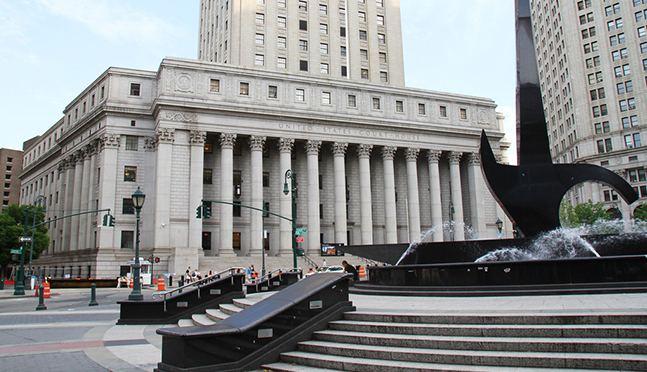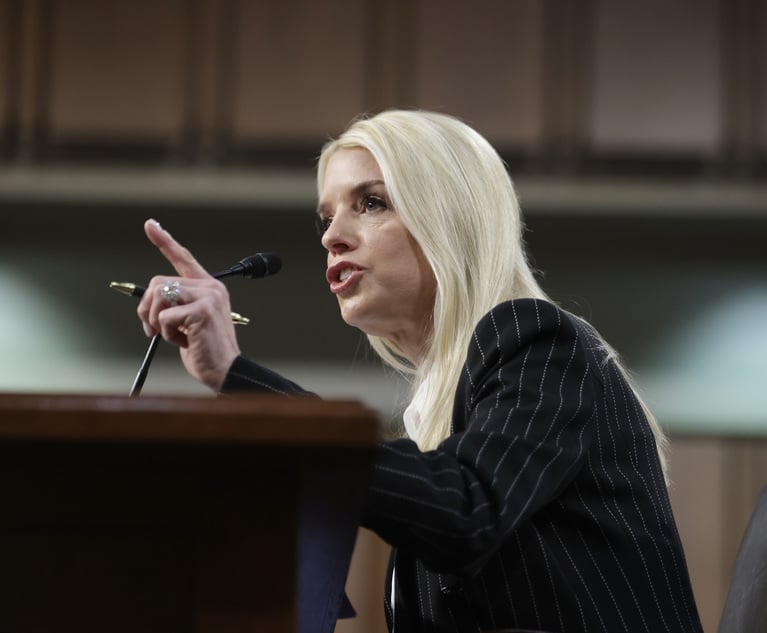2nd Circuit Issues Split Decision on Wage-and-Hour Settlements, But Issue Remains in Flux, Lawyers Say
Some attorneys on Monday told the New York Law Journal that the pointed language in both opinions indicated strong feelings within the Second Circuit on both sides of the issue and could signal that the court would consider rehearing the case en banc.
December 09, 2019 at 07:18 PM
6 minute read
 U.S. Court of Appeals for the Second Circuit. Photo: ALM
U.S. Court of Appeals for the Second Circuit. Photo: ALM
A sharply divided panel of the U.S. Court of Appeals for the Second Circuit has held that parties to federal wage-and-hour disputes are not required to obtain judicial approval for resolving claims under the Fair Labor Standards Act.
The ruling, in Yu v. Hasaki Restaurants, involved settlements under Rule 68 of the Federal Rules of Civil Procedure, a risk-shifting tool designed to encourage settlements in civil litigation by allowing defendants to send plaintiffs an offer of judgment at any point prior to 14 days before trial. Under Rule 68, if a plaintiff accepts the offer, a clerk is generally directed to automatically enter judgment, without a judge having to sign off on the agreement.
For FLSA cases, however, parties have run up against an obstacle in the 2015 Second Circuit decision known as Cheeks, which held that under a different rule judges must first determine whether the settlements are fair and reasonable to employees.
The ruling, handed down Friday, was welcomed Monday by attorneys on both sides of FLSA litigation who said the decision would remove a major roadblock to settlements and increase efficiency in bringing cases to a close.
"At the end of the day, acceptance of a Rule 68 offer in a FLSA case can hardly be viewed as a bad result, as it is a public judgment, accepted by a plaintiff after consultation with counsel, and puts an end to often contentious litigation," said Lou Pechman, a labor and employment expert at Pechman Law Group, who represented Hasaki.
"Whether or not you are a fan of Cheeks, the result in Hasaki is a positive one, and will be welcomed by FLSA practitioners in the trenches," he said.
For defense counsel, in particular, Hasaki would remove much of the red tape in settling cases that companies would prefer to see resolved quickly, said Noel Tripp, a principal in the Long Island office of Jackson Lewis.
"Employers defending themselves in FLSA litigation would want, and should be able, to use Rule 68(a) the same as any other civil defendant," said Tripp, who defends class and collective action lawsuits under federal and state wage-and-hour laws.
But it would also help eliminate delays for plaintiffs to get paid and likely cut down on unnecessary fees and other provisions that may have been needed under Cheeks to win the court's approval.
"I think it's a great decision for plaintiffs, defendants and the court alike," said Amanda Fugazy, head of the labor and employment law group at Ellenoff Grossman & Schole. "It will cut down on thousands of dollars in work getting arms-length agreements to completion."
"It's nice to have another avenue" that is "faster and potentially less expensive," Fugazy said.
In fact, the unusual procedural posture of the parties to the Hasaki litigation underscored the wide agreement within the bar to how FLSA settlements ought to be handled.
Attorneys for both the plaintiff, a sushi chef named Mei Xing Yu, and his former employer lined up against an order by U.S. District Judge Jesse M. Furman of the Southern District of New York that an agreement for $20,000 plus reasonable attorney fees was subject to judicial review under Cheeks.
In issuing his decision, Furman acknowledged that there could be "substantial grounds for difference of opinion" and certified the order for interlocutory appeal. The appeals court appointed Public Citizen Litigation Group to act as amicus and also invited the Secretary of Labor to argue in favor of Furman's position.
But the consensus among attorneys belied the strong feelings of judges on the Second Circuit panel that took up the issue on appeal.
In a forceful dissent, Second Circuit Judge Guido Calabresi said he "strongly" and "emphatically disagreed with the majority's holding that Rule 68′s command that the clerk must enter judgment is "mandatory and absolute."
According to Calabresi, the ruling created a new method for resolving liability under the FLSA that was not authorized by statute and ignored positions long held by the U.S. Supreme Court, the Department of Labor and federal appeals courts.
"The bulk of the majority opinion is spent seeking to distinguish cases that run against it. It repeatedly tries to explain why—though those cases are obviously in tension with the majority's result—the majority is not absolutely bound by them," he wrote in a 28-page dissent.
"Yet, in the end, the majority always returns to its one simple and simplistic argument: Rule 68(a) settlements are mandatory and subject to no controls, unless a statute precludes such absolute applicability, and the FLSA has no words precisely to that effect," Calabresi said.
Second Circuit Judge John M. Walker Jr., however, answered back in the majority opinion that the FLSA included no requirement for judicial approval, and declined to read one in. The Supreme Court, he said, never said that court‐supervised settlements might be valid under the FLSA, but rather that the act of filing a lawsuit may differentiate stipulated judgments from compromises by the parties.
"In other words, the act of filing the suit, airing the parties' dirty laundry in public and before a judge, and then coming to an agreement distinguishes stipulated judgments from private, back‐room compromises that could easily result in exploitation of the worker and the release of his or her rights," Walker said.
Joined by Judge Debra A. Livingston, Walker said Rule 68′s mandate was "unambiguous," and there was nothing to indicate that Congress intended to exempt the FLSA from its procedures.
"In light of the unambiguously mandatory command of Rule 68(a) for the clerk of the court to enter offers of judgment when they are accepted, and because we find no indication by Congress or the Supreme Court that the FLSA requires judicial approval of stipulated judgments concerning FLSA claims in the context of ongoing litigation, we decline to pull such a requirement out of thin air with respect to Rule 68(a) offers of judgment settling FLSA claims," he wrote.
Some attorneys on Monday told the New York Law Journal that the pointed language in both opinions indicated strong feelings within the Second Circuit on both sides of the issue and could signal that the court would consider rehearing the case en banc.
"The whole circuit is aware of the impact on practitioners," Tripp said. "I think they understand this is not some theoretical decision that lives in a dusty drawer somewhere."
Read More:
Second Circuit Revives Lawsuit Against Ohio Drugmaker, Saying Judge Mishandled Jurisdictional Query
Gibson Dunn's Boutrous Asks 2nd Circuit to Uphold Dismissal of City's Climate Change Suit
Carter Page Argues for Another Shot in Defamation, Terrorism Suit Against Yahoo Parent Company
This content has been archived. It is available through our partners, LexisNexis® and Bloomberg Law.
To view this content, please continue to their sites.
Not a Lexis Subscriber?
Subscribe Now
Not a Bloomberg Law Subscriber?
Subscribe Now
NOT FOR REPRINT
© 2025 ALM Global, LLC, All Rights Reserved. Request academic re-use from www.copyright.com. All other uses, submit a request to [email protected]. For more information visit Asset & Logo Licensing.
You Might Like
View All
Skadden and Steptoe, Defending Amex GBT, Blasts Biden DOJ's Antitrust Lawsuit Over Merger Proposal
4 minute read

Read the Document: DOJ Releases Ex-Special Counsel's Report Explaining Trump Prosecutions
3 minute read
After Solving Problems for Presidents, Ron Klain Now Applying Legal Prowess to Helping Airbnb Overturn NYC Ban
7 minute readLaw Firms Mentioned
Trending Stories
- 1SDNY Criminal Division Deputy Chief Returns to Debevoise
- 2Brownstein Adds Former Interior Secretary, Offering 'Strategic Counsel' During New Trump Term
- 3Tragedy on I-95: Florida Lawsuit Against Horizon Freight System Could Set New Precedent in Crash Cases
- 4Weil, Loading Up on More Regulatory Talent, Adds SEC Asset Management Co-Chief
- 5Big Banks Did Great Last Year. What Does That Mean for Big Law?
Who Got The Work
J. Brugh Lower of Gibbons has entered an appearance for industrial equipment supplier Devco Corporation in a pending trademark infringement lawsuit. The suit, accusing the defendant of selling knock-off Graco products, was filed Dec. 18 in New Jersey District Court by Rivkin Radler on behalf of Graco Inc. and Graco Minnesota. The case, assigned to U.S. District Judge Zahid N. Quraishi, is 3:24-cv-11294, Graco Inc. et al v. Devco Corporation.
Who Got The Work
Rebecca Maller-Stein and Kent A. Yalowitz of Arnold & Porter Kaye Scholer have entered their appearances for Hanaco Venture Capital and its executives, Lior Prosor and David Frankel, in a pending securities lawsuit. The action, filed on Dec. 24 in New York Southern District Court by Zell, Aron & Co. on behalf of Goldeneye Advisors, accuses the defendants of negligently and fraudulently managing the plaintiff's $1 million investment. The case, assigned to U.S. District Judge Vernon S. Broderick, is 1:24-cv-09918, Goldeneye Advisors, LLC v. Hanaco Venture Capital, Ltd. et al.
Who Got The Work
Attorneys from A&O Shearman has stepped in as defense counsel for Toronto-Dominion Bank and other defendants in a pending securities class action. The suit, filed Dec. 11 in New York Southern District Court by Bleichmar Fonti & Auld, accuses the defendants of concealing the bank's 'pervasive' deficiencies in regards to its compliance with the Bank Secrecy Act and the quality of its anti-money laundering controls. The case, assigned to U.S. District Judge Arun Subramanian, is 1:24-cv-09445, Gonzalez v. The Toronto-Dominion Bank et al.
Who Got The Work
Crown Castle International, a Pennsylvania company providing shared communications infrastructure, has turned to Luke D. Wolf of Gordon Rees Scully Mansukhani to fend off a pending breach-of-contract lawsuit. The court action, filed Nov. 25 in Michigan Eastern District Court by Hooper Hathaway PC on behalf of The Town Residences LLC, accuses Crown Castle of failing to transfer approximately $30,000 in utility payments from T-Mobile in breach of a roof-top lease and assignment agreement. The case, assigned to U.S. District Judge Susan K. Declercq, is 2:24-cv-13131, The Town Residences LLC v. T-Mobile US, Inc. et al.
Who Got The Work
Wilfred P. Coronato and Daniel M. Schwartz of McCarter & English have stepped in as defense counsel to Electrolux Home Products Inc. in a pending product liability lawsuit. The court action, filed Nov. 26 in New York Eastern District Court by Poulos Lopiccolo PC and Nagel Rice LLP on behalf of David Stern, alleges that the defendant's refrigerators’ drawers and shelving repeatedly break and fall apart within months after purchase. The case, assigned to U.S. District Judge Joan M. Azrack, is 2:24-cv-08204, Stern v. Electrolux Home Products, Inc.
Featured Firms
Law Offices of Gary Martin Hays & Associates, P.C.
(470) 294-1674
Law Offices of Mark E. Salomone
(857) 444-6468
Smith & Hassler
(713) 739-1250






